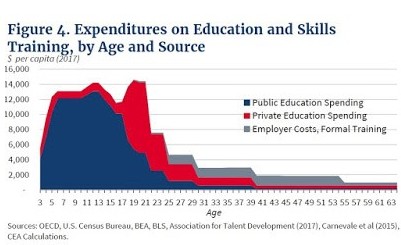Conversable Economist Tim Taylor presents a chart representing spending over a life time on Education and Skills in America. “Figure 4 (depicted) is from a report by the White House Council of Economic Advisers, titled “Addressing America’s Reskilling Challenge” (July 2018). The blue area shows public education spending, which is high during K-12 years, but the average spending per person drops off during college years. After all, many people don’t attend college, and of those who do many don’t attend a public college. Private education spending shown by the red area takes off during college years, and then trails off through the 20s and 30s of an average person. By about age 40, public and private spending on education and skills training is very low.
Topics:
run75441 considers the following as important: Hot Topics, run75441, Tim Taylor, US EConomics
This could be interesting, too:
NewDealdemocrat writes JOLTS revisions from Yesterday’s Report
Joel Eissenberg writes No Invading Allies Act
Bill Haskell writes The North American Automobile Industry Waits for Trump and the Gov. to Act
Bill Haskell writes Families Struggle Paying for Child Care While Working
Conversable Economist Tim Taylor presents a chart representing spending over a life time on Education and Skills in America.
 “Figure 4 (depicted) is from a report by the White House Council of Economic Advisers, titled “Addressing America’s Reskilling Challenge” (July 2018). The blue area shows public education spending, which is high during K-12 years, but the average spending per person drops off during college years. After all, many people don’t attend college, and of those who do many don’t attend a public college. Private education spending shown by the red area takes off during college years, and then trails off through the 20s and 30s of an average person. By about age 40, public and private spending on education and skills training is very low. Spending on formal training by employers, shown by the gray area, does continue through most of the work-life.
“Figure 4 (depicted) is from a report by the White House Council of Economic Advisers, titled “Addressing America’s Reskilling Challenge” (July 2018). The blue area shows public education spending, which is high during K-12 years, but the average spending per person drops off during college years. After all, many people don’t attend college, and of those who do many don’t attend a public college. Private education spending shown by the red area takes off during college years, and then trails off through the 20s and 30s of an average person. By about age 40, public and private spending on education and skills training is very low. Spending on formal training by employers, shown by the gray area, does continue through most of the work-life.
The figure focuses on explicit spending, not on informal learning on the job. As the report notes: “Some estimates suggest that the value of these informal training opportunities is more than twice that of formal training.” Nonetheless, it is striking that the spending on skills and human capital is so front-loaded in life. The report cites estimates that over a working lifetime from ages 25-64, the average employer spending per person on formal training totals about $40,000.”
